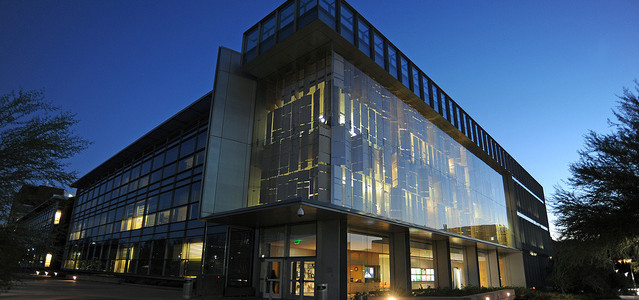Shandong University is sitting in an interesting position.
Situated in the heart of Qingdao, China, a city on the northern coastline that has been dubbed the nation’s “Blue Silicon Valley,” the university has an opportunity to take advantage of Qingdao’s intent to become an oceanographic research and commercialization center.
Part of its development includes a new Biodesign Center, the result of a collaboration with Arizona State University. It is part of ASU’s continued effort to deepen and expand research and related initiatives across China.
Earlier this week, representatives from SDU visited Tempe to meet with school officials on future collaboration and to see ASU’s Biodesign Institute, where researchers work to develop commercially viable health care, sustainability and security solutions by studying how the natural world is designed and how it functions.
ASU President Michael Crow said the Biodesign Institute was designed to “leapfrog” other institutions with its approach learning from natural processes. “We bring scientists in different areas all together in one place and let them build things as nature built, and design the way that nature designed,” he said. “Shandong University, with the new campus, has the opportunity to become a great leapfrog university in China, jumping over all of the others.”
SDU is using Crow’s New American University model to help it become one of China’s educational leaders. It is focusing on such broad-ranging topics as building a state-of-the-art academic innovation hub, fusing research disciplines using ASU’s use-inspired research approach and fostering STEM education.
As one of China’s leading materials scientists, SDU President Rong Zhang was fascinated by the Biodesign Institute’s next-generation sensor and biomarker array technologies.
Zhang, along with SDU’s Director of International Affairs Nan Zou, met with President Crow; Dr. Sethuraman “Panch” Panchanathan, senior vice president at ASU’s Office of Knowledge Enterprise Development (OKED); and other ASU officials, to discuss potential opportunities for research collaboration in areas such as materials science, DNA nanotechnology, biomarker development, bioremediation and sustainability.
Technology transfer has risen to prominence over the past three decades in China, and the Chinese government has adopted numerous policies to encourage international technology transfer, recently shifting its focus toward promoting U.S.-China advanced tech-transfer projects in new energy, new materials and sustainability.
President Zhang expressed strong interest in building a platform where transdisciplinary and collaborative research can be done across the two countries.
“Now that the Chinese government is supporting us to build more platforms in the new Qingdao campus, more new opportunities are here for us to take action, and like President Crow said, to ‘jump over’ our competitors,” Zhang said. “We know that Biodesign is where ASU’s research strengths are, and we’re also looking for new things that are natural, and Internet-related.”
At the Biodesign’s Center for Biosensors and Bioelectronics, Zhang met with the research team that created Breezing, the world’s first portable device that can track an individual’s metabolism.
Executive director Raymond DuBois outlined Biodesign’s broad goals of expanding its research portfolio and global partnerships, and pointed out such recent successes such as the formation of a new ASU-Banner Neurodegenerative Disease Research Center and biomarker development as opportunities where collaboration could have a broad impact on early disease diagnostics.
One of ASU’s leading nanotechnology scientists, Hao Yan, who directs Biodesign’s Center for Molecular Design and Biomimetics, is an alumnus and guest professor at SDU. Yan also joined the discussion to welcome President Zhang’s delegation and introduced his research projects at ASU to outline future directions and areas where faculty exchange programs and extending Biodesign’s research porfolio could broaden and strengthen ASU’s global partnerships with China.
Written by Jennifer Zhou and Joe Caspermeyer.

